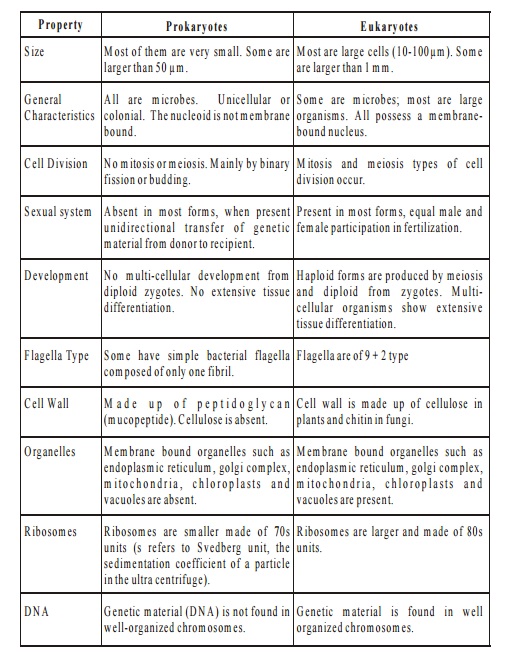Chapter: 11th 12th standard bio Biotany Plant Tree higher secondary school
Different Between Prokaryotic and Eukaryotic Cell (Plant Cells)

Prokaryotic and Eukaryotic Cell (Plant Cells)
All living things found on the planet earth
are divided into two major groups namely, prokaryotes and Eukaryotes based on the
types of cells these organisms possess. Prokaryotic cells lack a well defined
nucleus and have a simplified internal organization. Eukaryotic cells have a
more complicated internal structure including a well defined, membrane -
limited nucleus. Bacteria and Cyanobacteria are prokaryotes. Fungi, plants and
animals are eukaryotes.
Different Between Prokaryotic and Eukaryotic
Cell (Plant Cells)

Prokaryotes
In general, Prokaryotes consist of a single
closed compartment containing the cytosol
and bounded by the plasma membrane. Although bacterial cells do not have a well defined nucleus, the
genetic material, DNA, is condensed into the central region of the cell. In all
prokaryotic cells, most of or all the genetic information resides in a single
circlular DNA molecule, in the central region of the cell. This region is often
referred ot as incipient nucleus or nucleoid. In addition, most ribosomes,
the cell's protein synthesizing centres are found in the DNA-free region of the
cell. Some bacteria also have an invagination of the cell membrane called a
mesosome, which is associated with synthesis of DNA and secretion of proteins.
Thus we can not say that bacterial cells are completely devoid of internal
organization.
Bacterial cells possess a cell wall which
lies adjacent to the external side of the plasma membrane. The cell wall is
composed of layers of peptidoglycan, a complex of proteins and
oligosaccharides. It protects the cell and maintains its shape.
Some bacteria (eg E.coli) have a thin cell
wall and an unusual outermembrane separated from the cell wall by the periplasmic
space. Such bacteria are not stained by Gram staining technique and thus are
classified as Gram-negative bacteria. Other bacteria (eg.Bacillus polymyxa) that
have a thicker cell wall without an outer membrane take the Gram stain and thus
are classified as Gram positive bacteria.
Eukaryotes
Eukaryotes comprise all members of Plant
Kingdom, Fungi and Animal Kingdoms, including the unicellular fungus Yeast, and
protozoans. Eukaryotic cells, like prorkaryotic cells are surrounded by a
plasma membrane. However, unlike prokaryotic cells, most eukaryotic cells
contain internal membrane bound organelles.
Each type of organelle plays a unique role in
the growth and metabolism of the cell, and each contains a set of enzymes that
catalyze requisite chemical reactions.
The largest organelle in a eukaryotic cell is
generally the nucleus, which houses
most of the cellular DNA. The DNA of eukaryotic cells is distributed among 1 to
about 50 long linear structures called chromosomes.
The number
and size of the chromosomes
are the same in all cells of an organism but vary among different species of
organisms. The total DNA ( the genetic information) in the chromosomes of an
organism is referred to as its genome.
In addition to the nucleus, several other organelles are present in nearly all
eukaryotic cells, the mitochondria in
which the cell's energy metabolism is carried out, the rough and smooth endoplasmic reticula, a network of membranes in which proteins and
lipids are synthesized and peroxysomes,
in which fatty acids and amino acids are degraded. Chloroplasts, the site of photosynthesis are found only in plants
and some single celled organisms. Both plant cells and some single celled
eukaryotes contain one or more vacuoles,
large, fluid - filled organelles in which nutrients and waste compounds are
stored and some degradative reactions occur. The cytosol of eukaryotic cells
contains an array of fibrous proteins collectively called the cytoskeleton. Cytosol is the soluble
part of the cytoplasm. It is located between the cell organelles. The plant cell has a rigid cell wall composed of cellulose and
other polymers. The cell wall contributes to the strength and rigidity of plant
cell.
Some
familiar prokaryotes are: Bacteria,
filamentous bacteria (Actinomycetes)
and Cyanobacteria.
Some familiar eukaryotes are: Fungi, plants and animals.
Related Topics